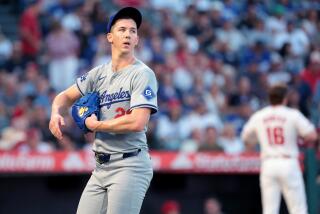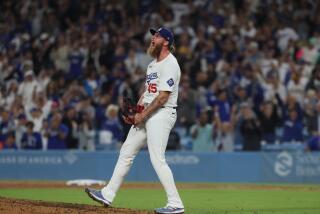Dodgers’ Kenta Maeda is a starting pitcher with a reliever’s mindset
The light-bulb moment for Kenta Maeda occurred June 9, long before the Dodgers right-hander transformed himself from starter to relief revelation during the team’s World Series run.
His rotation spot skipped because of an off-day that week, Maeda entered a Friday night game against Cincinnati in the sixth inning. It was his first relief appearance as a Dodger after making 32 starts in 2016 and 10 starts to open 2017.
Maeda retired the side in order with two strikeouts in the sixth and seventh innings, his fastball a tick or two higher than normal on the radar gun nd his slider sharp. A one-two-three eighth included another strikeout. Joey Votto hit a solo homer in the ninth, but Maeda finished off a 7-2 victory for his first save.
His pitching line: Four innings, three hits, one run, six strikeouts, no walks. Of his 60 pitches, 42 were strikes.
“We felt his season kind of turned around when he went to the bullpen the first time,” Dodgers pitching coach Rick Honeycutt said. “It seemed like something clicked that night.”
The numbers support Honeycutt’s theory. Maeda had a record of 4-3 with a 5.16 earned-run average in his first 10 starts last season, yielding a .762 on-base-plus-slugging percentage, striking out 53 and walking 17 in 52 1/3 innings.
In his next 18 games, 15 of them starts, Maeda had a record of 9-3 with a 3.69 ERA, yielding a .686 OPS, striking out 81 and walking 17 in 78 innings.
The difference was in Maeda’s approach, a more aggressive, attacking mindset that served the Dodgers well for the rest of the season — and especially during the playoffs. Maeda logged an 0.94 ERA in nine postseason relief appearances, struck out 10 batters in 10 2/3 innings and limited opponents to a .135 batting average.
“I know for me, when I went to the bullpen, it was like, ‘Why didn’t I have this mentality as a starter?’ ” said Honeycutt, who pitched 21 big-league seasons. “I think a lot of times starters try to hold a little in the tank thinking they’re going to go deeper into games.
“You kind of want that [relief] mentality of going batter to batter, inning to inning. Instead of focusing on something you can’t control five or six innings down the road, you can control the present. Kenta was so dominant in the playoffs, you want him to carry a little bit more of that into his starts.”
He did in his first game this season, throwing five shutout innings with 10 strikeouts and one walk in a March 31 win over San Francisco. According to Brooks Baseball, Maeda averaged 93.8 mph on the 50 four-seam fastballs he threw, with a maximum of 95.8 mph.
Maeda’s fastball averaged 90.0 mph in 2016 and 91.5 mph in 2017.
A rainout and three off days in an eight-day span pushed Maeda to the bullpen last weekend, and he threw a scoreless inning against the Giants on Saturday. But Maeda will return to the rotation to start the opener of a three-game series against Arizona at Dodger Stadium Friday night.
“Yes, my intention has changed this season,” Maeda, speaking through an interpreter, said earlier this week. “Being able to attack the hitter all of the time aggressively is something I’m really focusing on. Having put up good results [in October] definitely adds to my confidence. I think it’s a style I’d like to carry over.”
The Dodgers are curious to see how long Maeda can maintain a livelier fastball as a starter.
“Maybe he’s not to the point where he can hold those velocities for 90 to 100 pitches, but I do feel like he can throw 92-93 mph and occasionally 94 mph, like he did in his first game,” Honeycutt said. “That’s different than 88-89 mph.
“Adding 2-3 mph would be significant for anybody. There’s a different energy level. I think the hitter senses it too — the pitcher is in attack mode, he’s coming at you, and he’s not just trying to hit his spots and locate.”
Maeda’s short but successful track record in the bullpen gives the Dodgers options should their late-inning relievers falter, but neither the team nor Maeda has any interest in a full-time move to the bullpen. That would cost the pitcher millions.
Maeda’s incentive-laden eight-year, $25-million contract includes incentives for starts and innings pitched that can boost his pay by $10 million a year.
Including his $3 million base salary, Maeda earned $11.9 million in 2016, when he made 32 starts and threw 175 2/3 innings, and $7.9 million in 2017, when he made 25 starts and threw 134 1/3 innings.
“I was signed as a starter, and that’s what the Dodgers expect me to do, so putting up results as a starter is very important to me,” Maeda said. “At the same time, when you’re in the post-season, the goal changes, and it’s about winning the World Series. I’m just glad that I can help the team in another capacity.”
Maeda made four relief appearances during the 2017 regular season and embraced a relief role in the playoffs. He did not complain when he was bumped to the bullpen last week, a move that would be tougher for the Dodgers to make if Maeda was selfish.
“I think Kenta understands that our No. 1 goal is to win baseball games, and it’s not to prevent a player from maximizing his earnings,” manager Dave Roberts said. “I’m honestly not privy to the exact details [of his contract], but it does make it a lot easier when Kenta is on the same page as we are.”
More to Read
Are you a true-blue fan?
Get our Dodgers Dugout newsletter for insights, news and much more.
You may occasionally receive promotional content from the Los Angeles Times.











